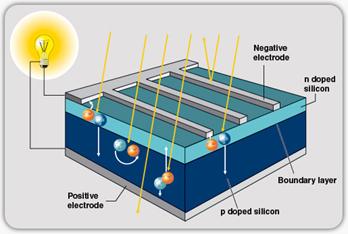Photovoltaic
The energy of the sun can be used to produce electrical energy. Photovoltaic is the technical term for the conversion of sunlight into electrical energy by the use of so-called PV or solar cells. They have been in use in everyday live in small calculators, wristwatches and parking payment machines and in larger systems on the roofs of buildings for a long time. By connecting single PV cells to modules, PV units are created that can be used to generate electricity from a few up to 100 Watts of direct current (DC). Apart from using this electricity to power electrical equipment, an inverter can transform the direct current into alternating current (AC) which can be fed into the electricity grid.
PV systems can be operated as stand-alone solutions. The generated electricity is directly used or temporarily stored in batteries – e.g. at night, when sunlight is not available and the electricity which was generated during the day can be used for electricity consumption. However, grid-integrated systems are experiencing global growth at the current state.
Until now, nearly 90% of all PV cells have been made of crystalline silicon, which was field tested over several decades. But there has been technical development lately and so-called thin-film cells are seen as a future option as well. These thin-film cells can be produced at lower cost since they are much thinner than the cells made from crystalline silicon.
• Crystalline silicon
Crystalline silicon is still the most important component of PV cells. Although it is actually not the ideal material for these cells, it is the second most abundant element in earth's crust and widely available, long tested and uses the same technology which was developed for other purposes. More than 20 % of energy efficiency has been reached with silicon cells in tests, but in serial generation cells are currently averaging efficiency between 13 to 17 %. The theoretical limit for crystalline modules approaches 30 %.
• Thin film
Thin film modules are constructed by depositing extremely thin layers of photosensitive materials on a low cost backing such as glass, stainless steel or plastic, which guarantee low production costs. Although the thin film cells have a price advantage, they are working with lower efficiency rates and they are not as well tested as the cells made of crystalline silicon. All of the currently available thin film cells have active layers that are only a few microns thick. The market share of thin film technology is still low, but is expected to increase in the future.
  The technological principle of the silicon PV cells is based on semiconductor silicon that is connected in various layers which produce an electric field. Semiconductors are materials, which become electrically conductive when supplied with light or heat, but which operate as insulators at low temperatures. When hit by sunlight, the electric field separates negative and positive charges which are available at the poles of the cell – comparable to a normal battery. PV cells function also without direct sunlight but the energy production is significantly smaller when it is cloudy. The technological principle of the silicon PV cells is based on semiconductor silicon that is connected in various layers which produce an electric field. Semiconductors are materials, which become electrically conductive when supplied with light or heat, but which operate as insulators at low temperatures. When hit by sunlight, the electric field separates negative and positive charges which are available at the poles of the cell – comparable to a normal battery. PV cells function also without direct sunlight but the energy production is significantly smaller when it is cloudy.
Cost reductions from both increased manufacturing volume and such improved technology are expected to continue to drive down cell prices in the coming years to a level where the cells can provide competitively priced electricity on a large scale.

The most obvious advantage of PV cells is emission-free electricity generation. Furthermore, the needed fuel – sunlight – is delivered free of cost by nature. Technically, the modules are easy to install and flexible in use: more modules can be added at any time if needed. Low maintenance is needed to keep the system running and a long life span adds up to the easy implementation of a small PV unit. However, the owner has to deal also with rather high investment costs and has to install a backup system to guarantee security of supply at all times. PV cells cannot be installed everywhere, since a substantial surface is required.
Costs for PV systems depend on different criteria like size, type of PV cell and state of the building in question. The size of the system complies with the amount of electricity required, but the majority of domestic systems are installed with a capacity between 1.5 and 3 kW. Solar tiles are more expensive than conventional panels and panels that are integrated into the roof cost more than those that are mounted on top. PV systems are ideally used for a building with a roof or wall that faces within 90 degrees of south, as long as no other buildings or large trees are taking away the sunlight. If the roof is in shadow, the output of the system diminishes.
|